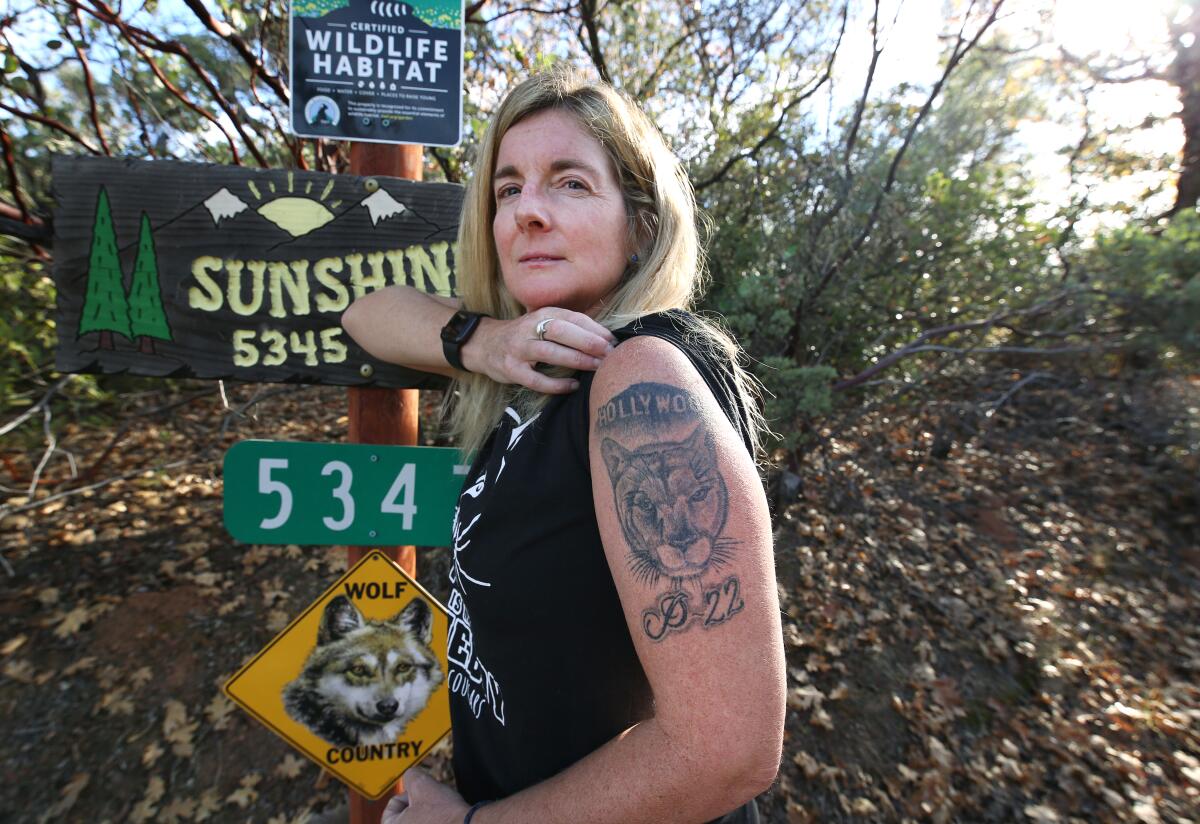Mission accomplished: Beth Pratt raised millions for a freeway overpass for L.A. cougars

- Share via
MIDPINES, Calif. — On a warm spring morning in 1976, when Beth Pratt was 7 years old, she noticed a “For sale” sign posted in the woods near her home just north of Boston.
“I asked my mom what it meant,” she recalled. “She said the land was up for sale and would soon be flattened by bulldozers.”
The next day, Pratt went door to door in her neighborhood of old elms and deep porches asking for donations to save one of her favorite outdoor playgrounds. Then she called the phone number on the sign and made an offer: $5.
After several seconds of silence, the person on the other end of the line said, “Wonderful. Just $40,000 more and that property is all yours.”
Today, Pratt is still raising money for causes she believes in. At 52, Pratt heads the nonprofit National Wildlife Federation’s #SaveLACougars campaign, which seeks to raise funds to build an $87-million bridge that will allow isolated clans of cougars to cross a 10-lane stretch of the 101 Freeway at Liberty Canyon Road in Agoura Hills.
To get a full measure of her dedication to the cause, start with the campaign’s poster puma, P-22. A likeness of the lone mountain lion prowling the chaparral-covered slopes in Griffith Park is tattooed on Pratt’s upper left arm.
Groundbreaking is just around the corner. The thought of it brings a proud smile to her face.
“When I took on this assignment I thought, well, how hard can it be?” Pratt said, shaking her head. “I didn’t dream it would grow into a nearly $100-million project that would consume almost 10 years of my life.”
When it is completed, the 200-foot-long, 165-foot-wide bridge will be the largest and most expensive of its kind in the world — and the only one designed to save a species from extinction.
It is crucial, scientists say, to restoring gene flow among small, isolated populations of cougars trapped south of the freeway that roars with 300,000 vehicles each day in the Santa Monica Mountains and cougars confined to the north in the Simi Hills and Santa Susana Mountains.
Recent scientific studies suggest there’s an almost 1 in 4 chance that Southern California mountain lions, which have the lowest genetic diversity documented for the species aside from the critically endangered Florida panther, could become extinct within 50 years.
The next few months are vital for those cougars and for Pratt, regional executive director in California for the federation. As of early December, the effort still needed $5 million to meet deadlines and contractual obligations.

Yet Pratt looked pleased on a recent morning, writing grant proposals and soliciting donations over the phone in her home near Yosemite National Park. Her living area is filled with artistic renderings and life-size cardboard cutouts of mountain lions.
She had reason to be pleased. Future historians may look back on the second decade or so of 21st century American architecture as the Age of Wildlife Crossings. Congress in November passed a national infrastructure package that for the first time sets aside $350 million in federal funding for wildlife crossings to reduce wildlife-vehicle collisions in all 50 states.
This would not have been the situation most people would have predicted when Pratt took on the tricky fundraising job. Wildlife bridge proposals, she quickly learned, come with a hitch: You need money to get past the blueprints, but you need blueprints to generate donations.
It’s rare these days — and almost impossible — to see a big-bucks urban wildlife project survive such long odds, particularly in a region that is home to unbearable traffic jams, smog and cookie-cutter planned developments.
Her ability to raise money in breathtaking amounts owes, in part, to a group of connected L.A. Westsiders — celebrities, corporate leaders and philanthropists — who have ready cash and enjoy throwing elegant private fundraisers for progressive causes.

While the Westside may not be the natural habitat of a self-described “goofy, loud, middle-class Boston Irish woman” who dresses in blue jeans and worn tennis shoes, Pratt learned that she could successfully coax the likes of Leonardo DiCaprio and Barbra Streisand without changing habits.
Pratt carries a backpack instead of a purse. At one Beverly Hills fundraiser, the host asked, “Are you going hiking after this?”
“I discovered that mountain lions are a great icebreaker when you don’t have much else in common,” she said. “For example, when I met my favorite actor, Viggo Mortensen, at a Santa Barbara film festival, I only talked about cougars and not about my 20-year crush on him.” Pratt shoved a furry P-22 figurine under his arm as a reminder.
Her other gifts are patience, energy, ambition and what Cinny Kennard, executive director of the Annenberg Foundation, described as “relentless competence.”
Between solicitations to prospective donors, Pratt has partnered with photographer Robb Hirsch to publish the first in-depth account of the wildlife in Yosemite in almost 100 years.
She also promotes the Liberty Canyon project during visits to local elementary schools and annually retraces the 20-mile odyssey that P-22 braved from the Santa Monica Mountains to Griffith Park. The cat’s route took him over concrete and backyards, commuter traffic and culverts.

“Some of her supporters have been moved to tears,” said Paul Edelman, deputy director of natural resources for the Santa Monica Mountains Conservancy, “seeing Beth emerge from the brush near the carousel at Griffith Park looking bedraggled, dusty and sunburned.”
When asked about her heroes, she quickly gives credit to Outdoor Afro founder Rue Mapp, who wants to bring healing hikes and what she calls the “outdoor Black experience” to more Americans.
Pratt sensed a kindred spirit in Mapp after they met about a decade ago. They both have great faith in the transformative power of the outdoors, and they both were struggling through personal issues while launching unprecedented projects that would define their careers and nurture new cooperative relationships between the urban and the wild.
“We became professional confidants who bonded in our own brand of sisterhood,” said Mapp, 49, a former Morgan Stanley analyst whose Outdoor Afro has expanded into a nonprofit with chapters in 36 cities across the nation. “For us, it was like Stars Wars’ Yoda says, ‘Do or not do. There is no trying.’”
::
The #SaveLACougars campaign kicked off in 2014 after the National Wildlife Federation and the Santa Monica Mountains Fund joined forces to raise money for the project at Liberty Canyon, about 30 miles northwest of Los Angeles.
“Normally, the majority of funding for projects of this scale comes from government agencies and not private donations,” Pratt said. “But the incentive was powerful to act quickly and reach out to visionary private investors or the lions of L.A. County would vanish within our lifetime.”
One of Pratt’s first donors was veteran rocker David Crosby. “This has always been a very uphill project and Beth is a very brave, focused and strong girl,” he said. “I plan to be there when they cut the ribbon on that wildlife bridge.”

Since 2020, wildlife biologists have discovered the physical manifestations of extremely low genetic diversity among several of the dozen cougars that roam the 275 square miles in and around the Santa Monica Mountains National Recreation Area — a tail kinked like the letter “L,” only one descended testicle and abnormal sperm.
In the face of such a dire prognosis — what biologists call an extinction vortex — conservationists are stepping up calls for construction of the Wallis Annenberg Wildlife Crossing at Liberty Canyon.
As envisioned by architects and Caltrans, cougars would move unseen by humans over a reinforced concrete-and-steel wildlife crossing landscaped with native vegetation — including oak and willow trees — and irrigation systems, and shielded with sound walls and light deflectors to dampen the noise and glare of headlights below.
Fencing up to 12 feet high would funnel wildlife including mountain lions, bobcats, deer, coyotes, skunks, badgers, squirrels, mice and lizards over the passage. To reduce roadkill, fencing would also extend several miles in both directions from the project footprint.
Project partners include the California Department of Transportation, the National Park Service, the Santa Monica Mountains Conservancy, the Resource Conservation District of the Santa Monica Mountains, and the National Wildlife Federation.
Because the bridge crosses the freeway, Caltrans will oversee design and construction — but the agency is not providing funding. Instead, most of the funds come from more than 3,000 private, philanthropic and corporate donors around the world, including a recent $25-million challenge grant from Wallis Annenberg and the Annenberg Foundation.
Mountain lions as a species are not threatened in California, but the state Fish and Game Commission has granted cougars in six regions from Santa Cruz to the U.S.-Mexico border “candidate status” to be listed as threatened sometime next year.
The action came in response to a petition co-sponsored by the Center for Biological Diversity and the nonprofit Mountain Lion Foundation. It argues that six isolated and distinct cougar clans within those regions make up a subpopulation that is threatened by extinction.
“In car-centric California, what we do with our roads is critical to the future of mountain lions,” said Brendan Cummings, the center’s conservation director. “A new, more hopeful relationship is breaking ground on the side of the 101 Freeway at Liberty Canyon.
“This project is significant not just because it will directly benefit our endangered Southern California cougars,” he added, “but also because of what it represents: the most important step toward reimagining and rebuilding our infrastructure to ensure a continuing place for them and other wildlife in 21st century California and beyond.”
Not everyone is a believer, however. Critics ask why we should willingly share more space in our crowded world with stealthy, 140-pound predators who kill livestock and might menace us if we walk down a trail at night.
Pratt has answers. And there is an edge of impatience mixed with her self-effacing humor as she delivers them.
“I don’t want to see people hurt, but it’s important to put the risk in perspective,” she says. “Over the past century there’ve been less than 20 mountain lion attacks in California, six of them fatal. Yet, 3,000 to 4,000 people die every year on California’s highways.
“So c’mon,” she adds, “ask yourself when was the last time you helped pull an endangered lion back from the edge of extinction?”
There have been tumultuous years. But by perseverance and a generous measure of personal charm, Pratt has become California’s most recognizable promoter of wildlife crossings.
“Beth rocks,” said Fraser Shilling, co-director of the Road Ecology Center at UC Davis. “I’d like to see her apply her considerable organizing powers to other roads driving local lions toward extinction.”









